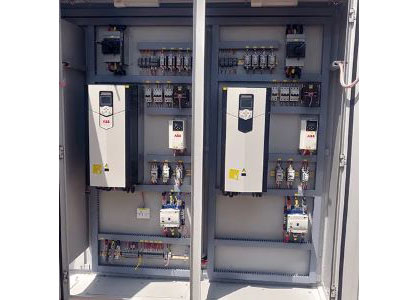Key Takeaway
kVA, or kilovolt-amperes, measures the effective size of a Variable Frequency Drive (VFD) based on the output voltage and current it supplies. For a three-phase VFD, kVA is calculated using the formula: kVA = Volts × Amps × √3. This value represents the apparent power and helps account for system inefficiencies. Knowing the kVA rating is essential when sizing components like transformers and fuses for the VFD. It is also useful for selecting the right generator size to power the VFD when backup power is needed.
Definition and Importance of kVA
kVA stands for kilovolt-amperes, a unit that measures apparent power in an electrical system. It combines the voltage and current supplied by the VFD to the motor. Apparent power includes both real power (measured in kilowatts, kW) and reactive power, which doesn’t perform any actual work but is necessary for the functioning of inductive loads like motors. Understanding kVA helps in sizing VFDs correctly to ensure they can handle the power demands of connected motors without overheating or becoming inefficient. For instance, if a VFD is rated too low in kVA, it might fail to supply adequate power, leading to operational issues.

Role of kVA in VFD Operation
The kVA rating of a VFD is a critical factor that influences its performance and efficiency. VFDs regulate motor speed and torque by adjusting the frequency and voltage supplied. An appropriately rated kVA ensures the motor receives the correct power level, essential for maintaining optimal performance.
In industrial applications, particularly those involving heavy-duty tasks, a higher kVA rating is often necessary. This is because such applications demand increased power during startup and under varying loads. For instance, large machinery or motors used in manufacturing require a substantial power surge initially to overcome inertia. A VFD with a suitable kVA rating can handle these demands without experiencing voltage drops or overheating.
However, if the kVA rating is incorrect, it can lead to several issues. Undersized VFDs may overheat, causing frequent trips and potential damage to both the VFD and the motor. On the other hand, an oversized VFD might be inefficient and costly. Thus, selecting a VFD with the right kVA rating is crucial for ensuring reliable and efficient motor operation.
You May Like to Read
Calculating kVA for VFDs
Calculating the kVA for Variable Frequency Drives (VFDs) is crucial for ensuring the efficient operation of industrial motors. The formula used is:
kVA = kW / Power Factor
For example, if a motor requires 50 kW and operates at a power factor of 0.8, the kVA rating needed would be:
kVA = 50kW / 0.8 = 62.5kVA
This calculation ensures that the VFD can handle the motor’s power requirements, including the reactive power component. Accurately determining these values is essential to avoid under-sizing or over-sizing the VFD. Under-sizing can lead to inefficiencies and potential equipment failure, while over-sizing can be costly and unnecessary.
When explaining this to a new engineer, emphasize the importance of both the active power (kW) and the reactive power (dictated by the power factor). Ensure they understand that the kVA rating must encompass both to provide the motor with the required power. This is not just about getting the numbers right; it’s about ensuring the longevity and efficiency of the motor and the VFD. Proper sizing helps in maintaining optimal performance, reducing downtime, and preventing potential failures, thus securing smooth industrial operations. Always verify these calculations and consult with experienced colleagues or resources to ensure accuracy and reliability.
Practical Applications of kVA
In the industrial sector, grasping the significance of kVA (kilovolt-amperes) ratings in Variable Frequency Drives (VFDs) is crucial. Correctly applying these ratings can drastically enhance operational efficiency. For instance, in a manufacturing plant, using VFDs with the appropriate kVA ratings ensures that equipment like conveyor belts and pumps function seamlessly, minimizing unexpected downtimes.
When planning electrical infrastructure, knowing the kVA requirements is essential. This knowledge aids in the selection and installation of transformers and circuit breakers that can adequately support the load. This proactive planning prevents potential issues such as overloads or electrical failures.
Furthermore, proper kVA management leads to significant energy savings. By ensuring that equipment runs efficiently, companies can reduce operational costs. Efficiently running machinery not only consumes less power but also experiences less wear and tear, extending its lifespan and reducing maintenance expenses.
Common Misconceptions and Clarifications
One common misconception is that kVA and kW are interchangeable terms. However, kW measures actual power, while kVA measures apparent power, which includes both real and reactive power. Understanding this distinction is crucial in industrial applications.
Another misconception is that higher kVA always means better performance. This is not true. The kVA rating should match the specific requirements of the motor and application. Over-sizing can lead to unnecessary energy consumption and higher costs. Conversely, under-sizing can cause operational problems and reduce the lifespan of equipment.
It’s essential to understand these differences to ensure optimal VFD performance. For instance, selecting a VFD with an appropriate kVA rating helps maintain efficiency and reliability. Misjudging this can result in increased maintenance and operational issues.
In the industrial sector, knowledge about kVA and kW is vital. Properly sizing your VFD not only optimizes performance but also ensures cost-effectiveness and longevity of the equipment. Remember, always consult with experts and use accurate calculations for the best results. Understanding these concepts can significantly improve your operations and prevent costly mistakes.
Conclusion
In summary, kVA is a critical parameter in the selection and operation of VFDs. It helps in determining the appropriate size of the VFD to match the power requirements of motors in industrial applications. Understanding kVA ensures that the VFD operates efficiently, avoiding issues such as overheating or insufficient power supply. By accurately calculating and applying kVA ratings, engineers can enhance the performance and reliability of industrial equipment, leading to smoother operations and reduced costs. For newly joined engineers, grasping the concept of kVA in VFDs is a foundational step towards mastering industrial automation and electrical systems.
